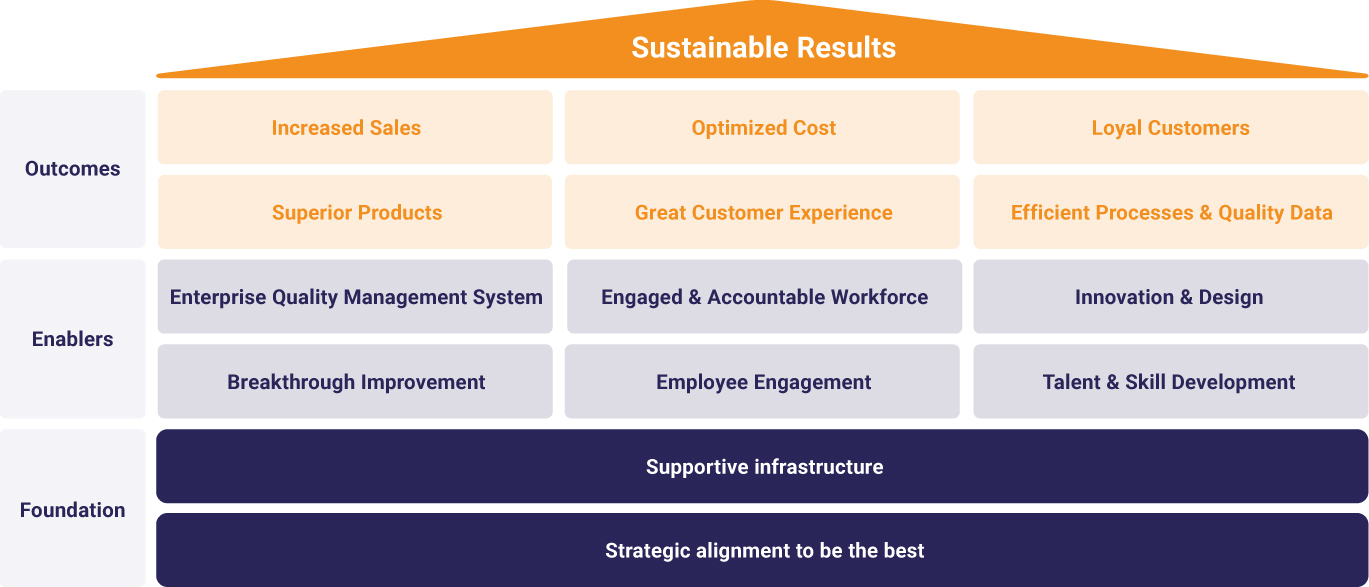The Juran Excellence Model
The Juran Excellence Model
A great business model for sustained performance begins here. For 40 years Juran has helped global organizations grasp some simple concepts that lead to sustained performance. This begins with understanding that it is important to develop your organization business model for quality or adopt one like the Juran Excellence Model. Our model applies to all industries, businesses, products, services, people and processes.
The Juran Excellence Model Components
The Juran Excellence Model consists of five key components, which together describe your approach to better business results and a culture of excellence:
1. A set of guiding universal principles
2. Great customer experience focused
3. Creating a structure and selecting the right methods
4. Launching of the right projects at the right time
5. Leadership and workforce engagement
The Guiding Principles
An important step to establishing a culture of excellence is to create a set of guiding principles that will underpin your approach to quality leadership. The Juran Excellence Model has four principles to drive improved business performance that has worked across all industries.
Principle 1: Embrace Quality Leadership as a business strategy. Quality is not just a word that your customers will use to convey the goodness or problems with your products and services. It is also a philosophy of being. To help deliver better business performance, your leaders and employees must understand what your customers mean and convey that throughout your organization. It means different things to different people, including your own employees and leaders. At Juran we can help you understand the two aspects of what quality means to them. First use the definition that your customers expect of all your products, services and interactions to be “fit for their purpose” in two distinct ways:
- The product & service must have the features that I want (the characteristics of your product that meets their needs and will impact sales)
- Be free from failure (it does not harm me, cost me more than I paid for it, inconvenience me or fail)
Principle 2: Believe that superior quality products and services always leads to sustainable financial performance. The Juran approach to exceeding your customers need for quality is embodied in the way your organization manages for quality. Organizations such as Amazon, Toyota and other successful companies do not just control quality they plan for it, design it in, and continuously improve on it. This is the Juran Trilogy at work. Managing for quality leadership requires three managerial processes all interrelated to each other.
Principle 3: Use The Juran Trilogy as the means to manage for excellence to ensure goods and service superiority.
- Quality planning (design quality in)
- Quality control (maintain what is designed)
- Quality improvement (create breakthroughs in current performance)
Principle 4: Adopt the Pareto Principle: You don’t have to improve everything. Your leaders must focus on the ‘vital few’ issues that will gain the most results.
The Juran "House of Quality"
We can help your organization adopt its own Quality Business Model similar to the Juran Excellence Model shown here. The Model consists of three layers (floors in the house of quality):
1. Developing a strong foundation and business strategy to be the best.
2. Understanding and implementing ‘enablers’ including engagement of the workforce.
3. A clear set of outcomes that lead to quality leadership and sustaining business results.







